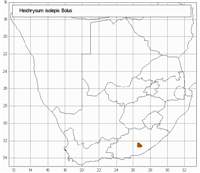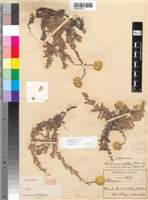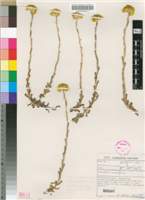Origin of name:
isolepis = with equal scales
Diagnostic characters:
Leaf margins and midveins woollyBracts bright yellowCompact inflorescenceLarge flower heads
Description:
Much-branched, straggling perennial herb, stems branching at ground level, decumbent, rooting, then erect to c. 300 mm, simple or subsimple, loosely white-woolly, closely leafy, more distantly so under the heads. Leaves c. 10�25 x 3�5 mm, diminishing upwards, oblong-obovate to oblong, apex subacute or obtuse, mucronate, uppermost with a yellow scarious appendage, base narrowed, half-clasping, both surfaces coarsely glandular-pubescent, cobwebby initially, margins thickened, they and the midvein below white-woolly. Heads homogamous, campanulate, c. 7 x 6�7 mm, several in a spherical cluster c. 20 mm across at the branch tips. Involucral bracts in 5 series, subequal, loosely imbricate, bases webbed together with wool, oblong-elliptic, tips very obtuse, somewhat crisped, about equaling flowers, semiglossy, bright canary-yellow, radiating. Receptacle shortly honeycombed. Flowers c. 24�35. Achenes 1.5 mm long, glabrous. Pappus bristles many, equaling corolla, tips barbellate, yellow, bases cohering by patent cilia.
Flowering in December and January.
Distribution:
Grows in stony mountain grassland, forming loose tangled clumps. Known only from the Great Winterberg and Katberg Pass in the Eastern Cape.
Thicket and Grassland Biomes.
Notes:
The habit is somewhat similar to H. montanum although the heads are very different. Leaves resemble those of certain forms of H. aureum and H. marginatum. Rarely collected.Taxonomy:
Literature:
Helichrysum isolepis H. Bol. in Trans. S. Afr. phil. Soc. 18: 385 (1907).
Type:
Eastern Cape, mountainside Great Winterberg, Queenstown distr., 8 iii 1900, c. 2 250 m, Galpin 2657 (K; PRE).
Synonym(s):
Vouchers:
Hilliard & Burtt 10957 (E; GRA; K; M; MO; NU; PRE; S).


